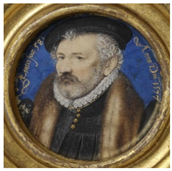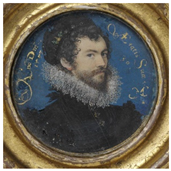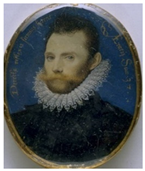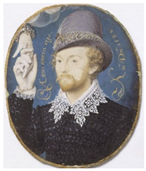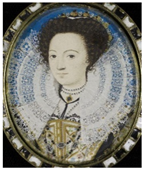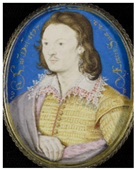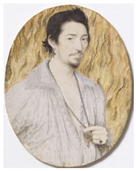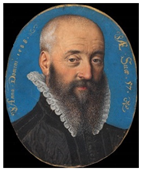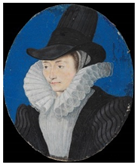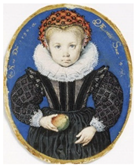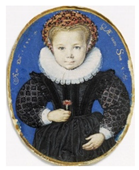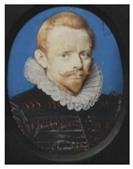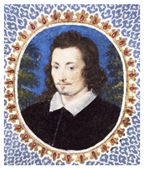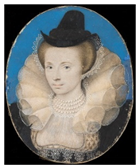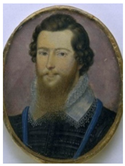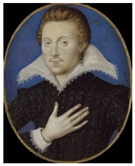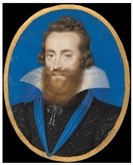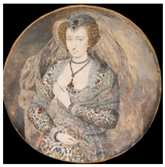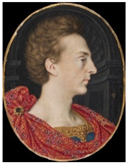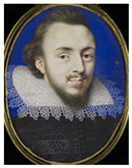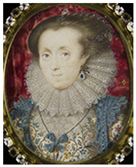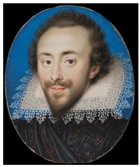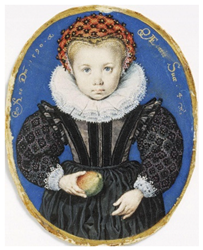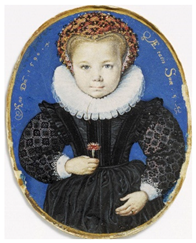Abstract
This study presents the results of the technical investigation carried out on several English portrait miniatures painted in the 16th and 17th century by Nicholas Hilliard and Isaac Oliver, two of the most famous limners working at the Tudor and Stuart courts. The 23 objects chosen for the analysis, spanning almost the entire career of the two artists, belong to the collections of the Victoria and Albert Museum (London) and the Fitzwilliam Museum (Cambridge). A non-invasive scientific methodology, comprising of stereo and optical microscopies, Raman microscopy, and X-ray fluorescence spectroscopy, was required for the investigation of these small-scale and fragile objects. The palettes and working techniques of the two artists were characterised, focusing in particular on the examination of flesh tones, mouths, and eyes. These findings were also compared to the information written in the treatises on miniature painting circulating during the artists’ lifetime. By identifying the materials and techniques most widely employed by the two artists, this study provides information about similarities and differences in their working methods, which can help to understand their artistic practice as well as contribute to matters of attribution.
1. Introduction
Miniature painting was a flourishing art form in 16th-century England. Characterised by a minute and impeccable technique and a specific purpose, and offered as a personal gift or to demonstrate devotion, portrait miniatures were painted on a vellum support glued to a playing card, with pigments generally bound in gum Arabic [1]. Other substrates included copper in the 17th century [2,3,4] as well as ivory from the beginning of the 18th century [5,6,7].
Working at the court of Elizabeth I, Nicholas Hilliard (1547–1619) is considered one of the most skilled and famous miniature painters (or ‘limners’); his style is characterised by accurate reproduction of jewels and metals, imitation of various textures of fabrics, and—from the 1580s onwards—pale flesh tones [8,9]. By the start of the 17th century, a burgeoning interest in Continental-style art meant that Isaac Oliver (c. 1565–1617), who almost certainly learned limning from Hilliard, could find patrons for his miniatures, which were influenced by Continental art [10].
Only a few, albeit significant, technical studies have been carried out on English portrait miniatures of the 16th and 17th centuries, generating an overview of several artists’ palette, chiefly Hilliard and Oliver [11,12]; however, the results were limited to a small number of objects, therefore not representing the entire timeframe of activity of the artists. A recently published paper [13] deals specifically with Oliver’s objects, exploring a few key discoveries concerning his technique and collaborations. However, overall, little attention has been paid to this art form, resulting in the lack of technical databases that would specify each artist’s materials and techniques and potentially help in addressing issues of attribution.
This article examines 23 miniatures from the collections of the Victoria and Albert Museum, London (V&A) and the Fitzwilliam Museum, Cambridge (FM). The objective of this work is to characterise the palette and advance the knowledge of the working techniques of Nicholas Hilliard and Isaac Oliver, two of the most famous limners working in England during the Tudor and Stuart period, by extending the number of objects being investigated in comparison to previous studies, as well as their timeframe.
By employing a non-invasive approach, fragile and small-scale objects can be carefully investigated, as sampling of this kind of artworks is usually not allowed and is generally considered unethical. All the miniatures have been documented through stereomicroscopy and optical microscopy in order to magnify the details; subsequently, X-ray fluorescence spectroscopy (XRF) was carried out on all the main areas of the objects, narrowing down the identity of the pigments and identifying the metals, and Raman microscopy was used to refine the investigation and confirm specific compounds.
The examination followed a systematic approach, exploring several different areas on each miniature [14]. This article focuses specifically on the materials and techniques used to paint flesh tones, mouths and eyes. In particular, the flesh area was investigated on the carnation, intended as the first flesh layer without any modelling. Additionally, the orange preparation layer under the gilded details, often visible and accessible for analysis, and the green paint passages were also analysed, providing a first understanding of the materials used for these parts. The scientific results were then compared to the information written in Hilliard’s treatise the Arte of Liming (1578) [15] and Norgate’s Miniatura or the Art of Limning (1627) [1], both unpublished at the time but which seem to have clearly circulated in manuscript form among artists [16].
This study provides an important opportunity to broaden the understanding of the technique of two artists by means of a non-invasive approach, identifying key features that characterise artists’ materials and technique, as well as helping in ascertaining the attribution of objects and thus refining the corpus of their artistic production. Finally, it offers new technical insights within the rich and wide context of English miniature-painting in the late 16th and early 17th centuries.
2. Materials and Methods
2.1. Objects
Seven miniatures painted by Nicholas Hilliard from the V&A collections were studied, as well as sixteen objects by Isaac Oliver: nine from the V&A and seven from the Fitzwilliam Museum (Table 1). The portrait of an Unknown Man (FM 3882) carries a tentative attribution to Oliver [17]; Sir Philip Sidney (630-1882) was in the past attributed to Oliver although it is now accepted as having been painted in the style of Oliver. Both will be further discussed in Section 3.2.2. In Table 2, the objects are listed in an approximate chronological order, as some of them have a wide date range.

Table 1.
Miniatures attributed to Isaac Oliver and Nicholas Hilliard © V&A, © The Fitzwilliam Museum.

Table 2.
Miniatures which have undergone technical and scientific examination.
2.2. Instrumental Methods
All the objects were examined under UV light to avoid retouched areas during the analyses. The miniatures belonging to the Fitzwilliam Museum were investigated as part of an ongoing research project on Oliver’s materials and technique and using an expanded analytical protocol [13].
Details of the objects were documented by using a Leica stereomicroscope with magnification ranging from 7.5x to 60x and a Leica Aristomet microscope equipped with three objectives (10x, 20x, and 40x), a 10x eyepiece, and an optical zoom of up to 2.5x.
Raman spectra were collected by a Horiba Jobin Yvon XploRA microscope, equipped with 638 nm and 532 nm diode lasers. The 50x objective lens was used to focus the laser on the objects, the laser power was usually kept below 1 mW, and the spatial resolution was between 1 and 2 µm, depending on experimental conditions.
The X-ray fluorescence (XRF) analysis was performed with an ArtTAX XRF spectrometer at 50 kV, 600 µA, and 100s (live time). The analysis spot was approximately 0.2 mm across. Published and in-house Raman databases were used for the interpretation of the results [18,19].
The Raman and XRF data collected from all the miniatures are reported in the Supplementary Materials. XRF analysis provided information on pigments and metals that are not the focus on the present paper, therefore these data are not referenced in the text.
3. Results
3.1. Nicholas Hilliard’s Painting Technique
According to stylistic studies [17], Hilliard’s technique for the flesh tones can be divided in two phases. The first one corresponds to his early miniatures, including the two objects that he painted in France (P.154-1910, P.155-1910) and a portrait of an unknown man (E.1177-1988) studied in this article. It is characterised by highly worked and fully modelled flesh tones, achieved by applying many layers of paint. The analyses showed a lead white and carbon black matrix scattered with red pigment particles, typically hematite and vermilion. This is also in accordance with the findings on a portrait of Henri III, recently discovered and associated to Hilliard’s work in France [20]. In the second group of objects, corresponding to his stylistic change during the 1580s, the flesh tones appear pale, with a preference for red lead as the main red components, although the use of red lakes, now faded, cannot be ruled out. Yellow pigments, such as lead tin yellow and goethite, were also identified, seldom mixed with azurite.
The results are described in Table 3 and corroborate what Hilliard described in his treatise. Lead white and red lead were indeed the materials he recommended to use for the carnation; in the case of a pale complexion the use of the red component, sometimes mixed with a small amount of masticote (a term that at this period should be understood as lead tin yellow [21,22]), was reduced, whereas for a swarthy one, masticote and ochres should be added [15]. Similar mixtures are also described by Norgate, although he does not mention the use of masticote [1]. Additionally, scientific analyses revealed the presence of vermilion, which was discouraged by Hilliard and Norgate in their treatises but was consistently employed in the flesh tones analysed.

Table 3.
Miniatures by Nicholas Hilliard which have undergone technical and scientific examination. Greyed-out cells indicate that no analysis was carried out.
The volume of the mouth was built up starting with two short brown lines painted at the corners (Figure 1); vermilion is the main pigment used for the lips during the French period, whereas from the 1580s, pink lakes and red lead are preferred. The separation line between upper and lower lip consisted of a red lake. These results confirmed what was written by Hilliard and Norgate, as the materials to be used for the mouth were lake, red lead, and a white pigment [1,15]. Vermilion was identified by scientific analyses as an additional pigment present.
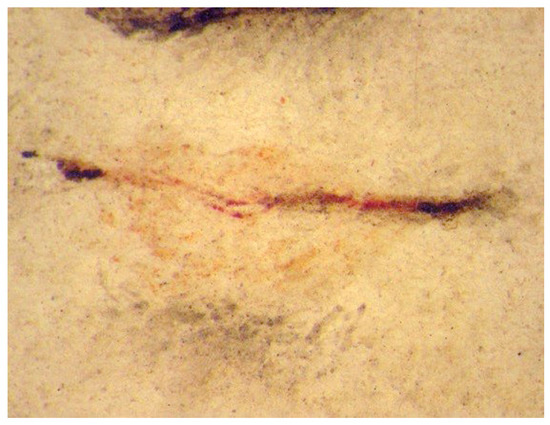
Figure 1.
Detail of the mouth’s features on Hilliard’s P.8-1945.
The eyes were investigated in several areas: the eyelash lines, the eyelid fold, and the inner corner. The eyelash and eyelid lines were generally traced with a black or a diluted brown pigment, probably of organic origin and partially faded. A second, darker line covered the first one and was made of carbon black and what looks like organic brown pigments (Figure 2a); on the later portraits, the second line appears to be applied only on the eyelash line and not on the eyelid fold (Figure 2b). The only exception is on E.1178-1988, where the first lines are traced with a red material. The presence of eyelashes is shown only on the portrait of an unknown woman (P.8-1945), where dots are painted on the lower eyelash line (Figure 2b).
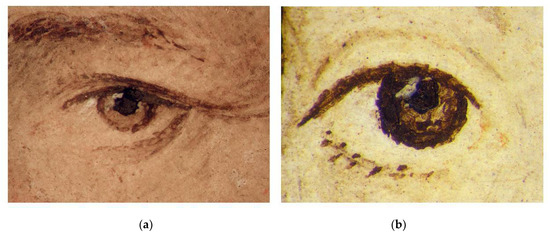
Figure 2.
Images of details on selected miniatures by Hilliard: (a) eye on P.154-1910 and (b) eye on P.8-1945.
Hilliard wrote that the outlines of the facial features should be drawn by a fine pencil (to be understood as a brush) with a faint rose colour made of a lake [15]; this probably corresponds to the brown lines of organic origin seen during the analyses.
The eyes’ inner corner, when visible, is painted with a red material, the composition of which varies for each miniature.
3.2. Isaac Oliver’s Painting Technique
The flesh tones on all the miniatures analysed consisted of a lead white matrix scattered with carbon black particles and red pigments added to obtain the desired hue, as previously seen with Hilliard. In Oliver’s case, red lead was the predominant red component identified on the majority of the objects, whereas vermilion is the second most-common one (Table 4 and Figure 3a). A few exceptions are found where vermilion is the only red pigment present (on FM 3882, P.145-1910 and E.1177-1988) or the predominant one instead of red lead (on 630-1882). On a few miniatures, red lead is mixed with other pigments, such as indigo, hematite, goethite, lead tin yellow type I, and possible yellow ochre (Figure 3b and Table 4). The absence of vermilion seems consistent on objects dated after at least 1610.

Table 4.
Miniatures by Isaac Oliver which have undergone technical and scientific examination. Greyed-out cells indicate that no analysis was carried out.
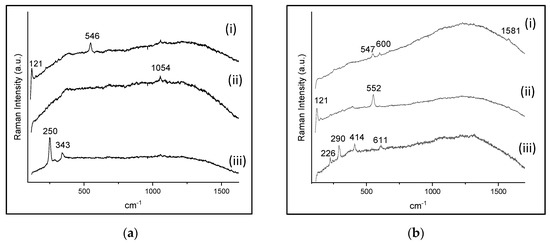
Figure 3.
Examples of flesh tones, (a) Raman spectra collected on FM 3902, dated 1605: (i–iii) red lead, lead white, and vermilion are detected; (b) Raman spectra collected on FM 3865, dated 1615: (i–iii) indigo, red lead, and hematite are detected, whereas vermilion is not found.
The volume of the lips appears to be built in the same way for most of the miniatures and similarly to what is found on objects by Hilliard (Figure 4). Two dark modelling lines are present at the corners of the mouth. Red lead was used as the preferred pigment for the lips, and it is absent only in 4 out of 16 objects; it is sometimes mixed with a pale pink lake or vermilion. Vermilion was the predominant component on P.145-1910 and 630-1882. In one of the two portraits of young girls (P.146-1910), the lips consisted mostly of a pink lake and neither red lead nor vermilion was identified. In almost all the miniatures, a separation line between upper and lower lip is applied at the end of the painting process using a dark pink lake.
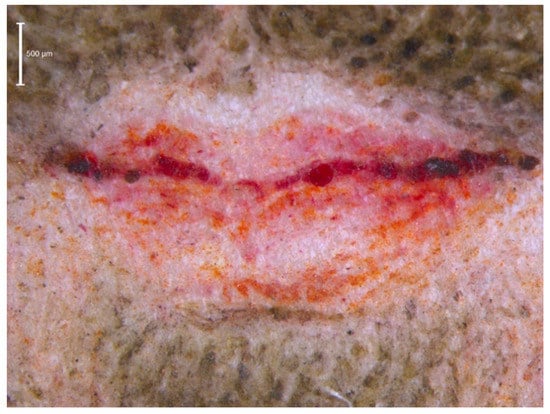
Figure 4.
Example of the mouth’s typical features on Oliver’s FM 3865.
To trace the lines of the eyelashes and eyelid, Oliver usually painted an initial red/pink line, which contains a mixture of black and red pigments, the latter preferably vermilion or hematite. A second, darker line was then painted over the first red one and was made of black particles only. This appears fainter on the eyelid lines and is usually visible only at the corners. The eyelashes are painted at the outer edge of the upper eyelash line—they are especially noticeable in the female portraits (Figure 5). Moreover, red lead applied between the eyelash and the eyelid lines is often visible.
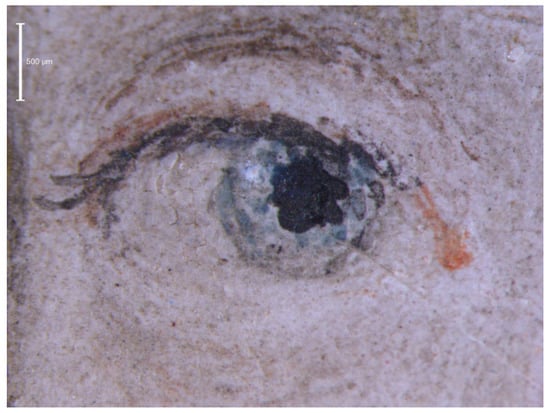
Figure 5.
Image of FM 3868 under the microscope: the initial red line tracing for eyelashes and eyelid line is present, and the eyelashes are painted at the edge of the upper eyelash line Table 4. Miniatures by Isaac Oliver which have undergone technical and scientific examination. Greyed-out cells indicate that no analysis was carried out.
The inner corner of the eye, when painted, contained a mixture of red lead and vermilion. Sometimes, red lead alone was identified, and in one case, vermilion alone was seen. On P.11-1947, hematite is added to the mixture of red lead and vermilion, whereas on P.145-1910, the unusual mixture of hematite and indigo was seen.
In conclusion, Oliver’s working technique for the flesh tones, the volume of the mouth and the eyes’ contour appears to be consistent for the whole period under study, and is characterized by a greater breadth of pigments employed. The presence of vermilion on the artist’s palette only before ca. 1610 can provide the grounds for a chronological difference.
3.2.1. Oliver’s Outliers
A few miniatures may be considered outliers, as the materials and techniques do not entirely fit with what was normally used by Oliver.
The V&A portrait of Robert Devereux (E.1177-1988) was heavily retouched during the 19th century, but the areas analysed in the flesh tones and the mouth, considered original following examination under UV, unusually do not contain red lead. It should be noted that many versions of this sitter’s portrait exist (i.e., NPG 4966 at the National Portrait Gallery, London; RCIN 420933 at the Royal Collection; and B1974.2.75 at the Yale Center for British Art). Other versions of the portraits of Sir Ludovic Stuart and Prince Henry are also extant [13]. The mechanisms behind the production of further versions are not clear, but it would appear that Oliver may have retained a workshop ’pattern’ for some sitters (e.g., the YCBA version of Deveraux). A technical study of other versions of the Robert Devereux portrait would likely yield useful comparative data and add relevant pieces of information about the collaboration between Oliver and his workshop.
The miniature of an Unknown Man (P.11-1929) showed a mixture of red lead and vermilion typically employed by Oliver on the flesh tones before 1610, thus in agreement with the dating of the object around 1590. However, the mouth contained only vermilion, while no red lead was identified. Moreover, the inner corner of the eyes and the eyelid lines were obtained with a mixture of hematite and vermilion, which was never observed on the other Oliver miniatures. The structure of the eyes and mouth also seems different from the other objects, as well as the heavily marked shading (Figure 6).
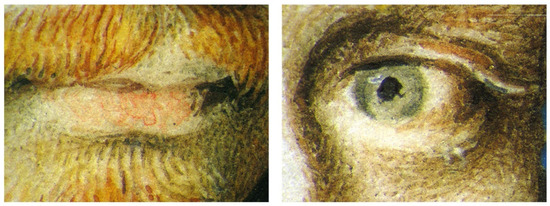
Figure 6.
Photomicrographs of facial features of P.11-1929.
The miniatures of the two little sisters, Young girl, aged 4, holding an apple (P.145-1910) and Young girl, aged 5, holding a carnation (P.146-1910), look similar at first sight; however, they display differences between them as well as to the pigment selection otherwise seen in Oliver’s miniatures (Table 5). For instance, flesh tones and mouths differ from Oliver’s technique: on P.145-1910, vermilion was the predominant pigment, whereas on P.146-1910, the flesh tones contained mostly red lead without vermilion. The latter case would fit the current evidence if the object was painted after 1610, following Oliver’s general pigment preference; however, the inscription within the miniatures (considered to be original) states 1590 as the year of the sitting. The structure of the eyes appeared similar on both objects (Figure 7a), although the materials used in each miniature were different and did not fully match the evidence from other Oliver works. Interestingly, on P.146-1910 some dots on the lower lid indicated the presence of eyelashes, in a similar way to what was found in one of Hilliard’s miniatures (Figure 7b). These two objects represent the only portraits of young girls analysed so far, which might perhaps account for the differences found. There is no doubt at all amongst scholars that both girls were painted by Oliver [8,17,23].

Table 5.
Results on miniatures P.145-1910 and P.146-1910 showing similarities and differences on the various areas analysed.
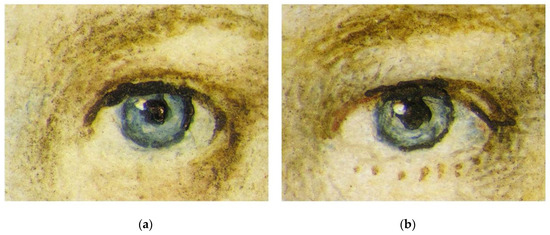
Figure 7.
Photomicrographs showing the proper left eyes of the two little girls portrayed by Isaac Oliver. (a) P.145-1910, (b) P.146-1910. In the latter image, the structure of the eye appears different and eyelashes are clearly present on the lower eyelash line.
3.2.2. Miniatures with Uncertain Attribution
Two of the miniatures we investigated, portraying Sir Philip Sidney (630-1882) and an Unknown Man (FM 3882), have, or had in the past, a tentative attribution to Oliver.
Oliver’s monogram on the miniature of Sir Philip Sidney (630-1882) suggested an attribution to this artist. However, stylistic evaluations raised doubts [24]. Scientific examination identified the predominant presence of vermilion in the flesh tones and mouth, not matching Oliver’s technique as revealed by the analyses reported thus far, which showed red lead as his preferred pigment. This evidence offers additional support to the statement that the miniature is ‘after Isaac Oliver’, as reported in the V&A records and in accordance to a previous study [11]. Although a prevalence of vermilion can be found on Hilliard’s objects, the investigation of the inner corner of the eye and the eyelash line raises doubts about the alternative attribution to Hilliard, too. Therefore, we confirm the exclusion of Oliver as the artist and possibly of Hilliard as well. One of their followers may have painted this object but the question of whom remains open, as no technical studies on any of these other artists have been published.
The second object with a potentially uncertain attribution to Oliver [17] is the portrait of a bearded Unknown Man (FM 3882). The object shows different materials and techniques in comparison with the other miniatures by Oliver in every paint passage studied. For instance, vermilion was the only red pigment used for the flesh tones, the mouth and the inner corner of the eyes, instead of the red lead preferred by Oliver. The structure of the mouth is also different: the lips are not separated by a line, the black corners are not present, and red hatching is visible instead of smooth brushstrokes (Figure 8). The technical evidence supports the suggestion that this miniature was not painted by Oliver, although it should be noted that this is the only portrait of an old man analysed, and the only one of a sitter with a darker complexion. A comparison with the results on Hilliard also allows the exclusion of this artist as an alternative attribution. Due to a lack of published data on other artists of that time, the identification of the highly skilled artist of this miniature remains impossible based on technical data alone.
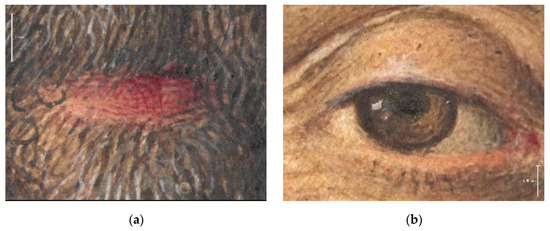
Figure 8.
Images of FM 3882 showing details of (a) the mouth and (b) the proper right eye.
3.3. Orange and Green Areas
Preliminary results from other paint passages beyond those discussed above are reported in this section, but as these were only investigated in a small number of miniatures, the findings cannot be used to outline specific, consistent material choices for either artist (Table 6).

Table 6.
Yellow and orange preparation under the gilding and green areas analysed on selected miniatures by Hilliard and Oliver. Greyed-out cells indicate that no analysis was carried out.
The metals used to reproduce the jewels were applied on an orange preparation layer. Hilliard painted a yellow layer covered by a second orange one, whereas Oliver used a single orange layer. The initial yellow layer painted by Hilliard contained mostly orpiment or lead tin yellow type I. Both artists preferred an arsenic sulfide as the orange pigment of choice, identified by the broad Raman band at 345 cm−1 as one of the intermediate phases between realgar and pararealgar [25,26,27] (Figure 9). Hilliard mixed it with lead tin yellow, hematite and red lead, whereas Oliver tended to use it unadulterated. Oliver also applied a mixture of hematite and goethite on the two objects dated after 1610; this piece of information may be linked to a chronological choice of pigments, but it requires further investigation through analysis on a larger number of miniatures. The only exception is the portrait of an Unknown Woman (P.43-1941), where a mixture of red lead and hematite was identified.
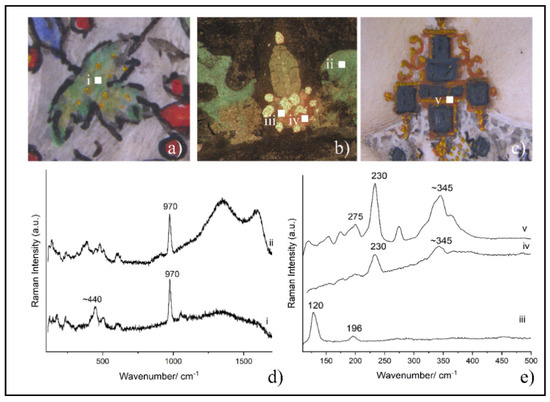
Figure 9.
(a) Example of a green area on Oliver’s FM 3902, the white square indicates the spot analysed by Raman; (b) examples of the orange and yellow areas under the gilding, as well as a green area on Hilliard’s P.155-1910; (c) example of the orange preparation under the gilding in Oliver’s FM 3902; (d) Raman spectra collected on the green areas of both Oliver and Hilliard’s objects, showing the presence of brochantite and carbon black; (e) Raman spectra on the yellow area of P.155-1910, where lead tin yellow type I is found, and on the orange ones, showing the presence in both cases of an arsenic sulfide (an intermediate phase between realgar and pararealgar).
In their treatises, Hilliard and Norgate condemned the use of orpiment as ill-smelling and toxic, and they suggest English ochre (yellow ochre) to be employed as preparation under the gilding. However, scientific analysis on Hilliard’s objects detected arsenic sulfides often used to obtain the yellow and orange layers laid under gold. Ochres seem to be preferred by Oliver instead.
Green details on the clothing and caps can contain green pigments or a mixture of yellow and blue ones. The only green compound identified in objects by both artists was the copper sulfate brochantite (Cu4SO4(OH)6) (Figure 9). This pigment has been identified on 16th- [28] and 17th-century objects [29] and especially on other miniatures by Oliver along with malachite [13]. In instances where green was obtained by mixing pigments, the mixture typically comprised azurite and indigo as blue pigments, used together or individually, and organic lakes as main the yellow ones. Both Hilliard and Norgate disapproved of the use of verdigris, which is indeed never identified in this study, and list cedar green (similar to chrysocolla, a copper silicate) and verditer (intended as copper carbonates) as green pigments, as well as mixtures of ‘pinke’ (yellow lake) and blue bice [1,15].
4. Discussion
All of the miniatures by Nicholas Hilliard and Isaac Oliver analysed during this as well as previous studies were painted with pigments commonly used in the 16th and 17th centuries. Although Oliver was probably briefly trained by Hilliard in the 1580s, this study highlights that the two limners have very distinct artistic personalities, each artist employing specific pigments at different times and often in different ways, as summarised in Figure 10 and Table 7. Possible competition between the two may have led to diverging and innovative artistic choices, such as Hilliard’s distinctive, minimalistic, and pale portraits versus the evident Continental influence in Oliver’s style, which appealed to certain patrons.
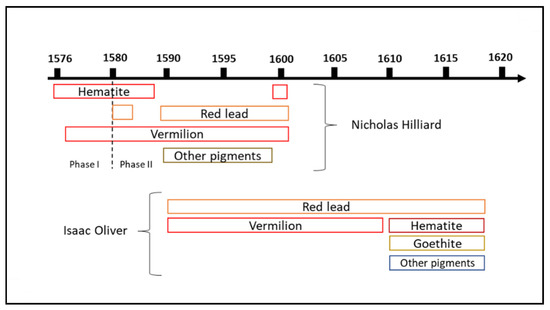
Figure 10.
Timeline showing the preferred pigments on the flesh tones used by Hilliard and Oliver. During Hilliard’s second phase, corresponding to paler portraits, red lead is the preferred pigment.

Table 7.
Comparison between Oliver and Hilliard’s technique based on the analytical data gathered during this study.
Nicholas Hilliard’s working practice reflects his artistic choices at different points during his career; the early, fully modelled portraits and his later, paler ones are technically similar in the way that the eyes and mouth are depicted, although clear differences exist in the flesh tones and the amount of modelling (the latter being close to absent). Interestingly, in his treatise, Hilliard mentioned various pigments for painting the ‘carnation’ layer but not vermilion, which was nevertheless identified widely in his works.
The overall trend for Isaac Oliver’s materials and painting technique is consistent for most of the miniatures analysed. The absence of vermilion in flesh tones after ca. 1610 may provide technical grounds for dating objects. The technical analysis established the presence of a number of outliers and confirmed that miniature FM 3882, currently tentatively attributed to Oliver, does not fit neatly within Oliver’s ‘typical’ materials and techniques.
5. Conclusions
This study makes a significant contribution to the existing knowledge on English portrait miniatures between the 16th and 17th centuries, providing technical results on several objects attributed to two of the most famous ‘limners’ of that time and advancing our understanding of materials and working methods behind the creation of these valuable objects. The use of a non-invasive analytical approach made it possible to gain data from a number of small, fragile artworks, for which sampling is not considered ethical. An expanded technical study that takes fully into account other areas of the objects in addition to flesh tones, such as the orange and green ones briefly mentioned in this article, as well as a larger number of Hilliard’s miniatures, may provide additional evidence to differentiate the two artists and refine the corpus of objects attributed to them. This could be of the utmost importance when objects have a history of alternating or uncertain attributions, as is the case for several of the miniatures attributed to both limners. The question about how many other artists were working as high-end miniaturists in England at the time remains unanswered; further research—both archival and technical—may clarify this point and enable a better understanding of the historical period and this distinctive kind of art that was so popular in England at the turn of the 17th century.
Supplementary Materials
The following are available online at https://www.mdpi.com/article/10.3390/heritage4030064/s1, XRF and Raman results.
Author Contributions
Conceptualization, F.F. and P.R.; methodology, L.B.; investigation, F.F., L.B., P.R., and C.S.K.; writing—original draft preparation, F.F.; writing—review and editing, L.B., P.R., and C.S.K.; visualization, F.F.; supervision, L.B. and P.R. All authors have read and agreed to the published version of the manuscript.
Funding
The analysis of the Fitzwilliam Museum miniatures at the V&A was possible thanks to support from the Cambridge Humanities Research Grants scheme.
Acknowledgments
The authors wish to thank Katherine Coombs, Alan Derbyshire, and Victoria Button (V&A), as well as Jane Munro, Henrietta Ward, Richard Farleigh, and Harry Metcalf (FM) for providing access to the miniatures and for fruitful discussions.
Conflicts of Interest
The authors declare no conflict of interest.
References
- Norgate, E. Miniatura or the Art of Limning; Yale University Press: London, UK, 1997. [Google Scholar]
- Veiga, A.; Mirao, J.; Candeias, A.J.; Rodrigues, P.S.; Teixeira, D.M.; Muralha, S.; Teixeira, J.G. Pigment analysis of Portuguese portrait miniatures of 17th and 18th centuries by Raman Microscopy and SEM-EDS. J. Raman Spectrosc. 2014, 45, 947–957. [Google Scholar] [CrossRef]
- Veiga, A.; Teixeira, D.M.; Candeias, A.; Mirao, J.; Manhita, A.; Miguel, C.; Rodrigues, P.S.; Teixeira, J.G. Micro-analytical study of two 17th century gilded miniature portraits on copper. Microchem. J. 2015, 123, 51–61. [Google Scholar] [CrossRef]
- Albini, M.; Ridolfi, S.; Giuliani, C.; Pascucci, M.; Staccioli, M.P.; Riccucci, C. Multi-Spectroscopic Approach for the Non-invasive Characterization of Paintings on Metal Surfaces. Front. Chem. 2020, 8, 289. [Google Scholar] [CrossRef] [PubMed] [Green Version]
- Mancini, D.; Tournié, A.; Caggiani, M.C.; Colomban, P. Testing of Raman spectroscopy as a non-invasive tool for the investigation of glass-protected miniature portraits. J. Raman Spectrosc. 2011, 43, 294–302. [Google Scholar] [CrossRef]
- Hradilová, J.; Hradil, D.; Pech, M.; Bezdička, P.; Neděla, V.; Tihlaříková, E.; Targowski, P. Complementary use of X-ray based imaging and analytical methods in the investigation of miniature portraits. Microchem. J. 2020, 153, 104371. [Google Scholar] [CrossRef]
- Tihlaříková, E.; Nedela, V.; Hradilova, J.; Hradil, D. Non-invasive Morphological and Elemental Analysis of Ivory Plate for Artworks Authentication Using ESEM and EDS. Microsc. Microanal. 2017, 23, 1832–1833. [Google Scholar] [CrossRef] [Green Version]
- Murrell, J. The Way Howe to Lymne. Tudors Miniatures Observed; Victoria and Albert Museum: London, UK, 1983. [Google Scholar]
- Leonhard, K. Painted Gems. The Color Worlds of Portrait Miniature Painting in Sixteenth- and Seventeenth-Century Britain. In Early Modern Color Worlds; Brill|Nijhoff: Leiden, The Netherlands, 2015; pp. 140–169. [Google Scholar]
- Button, V.; Coombs, K.; Derbyshire, A. Limning, the perfection of painting: The art of painting portrait miniatures. In Elizabethan Treasures: Miniatures by Hilliard and Oliver; National Portrait Gallery London: London, UK, 2019. [Google Scholar]
- Burgio, L.; Cesaratto, A.; Derbyshire, A. Comparison of English portrait miniatures using Raman microscopy and other techniques. J. Raman Spectrosc. 2012, 43, 1713–1721. [Google Scholar] [CrossRef]
- Derbyshire, A.; Withnall, R. Pigment analysis of portrait miniatures using Raman microscopy. J. Raman Spectrosc. 1999, 30, 185–188. [Google Scholar] [CrossRef]
- Kimbriel, C.S.; Ricciardi, P. Secrets of a Silent Miniaturist: Findings from a Technical Study of Miniatures attributed to Isaac Oliver. Br. Art Stud. 2020. [Google Scholar] [CrossRef]
- Fiorillo, F. Assessment of a Best Practise Approach for the Attribution and Authentication of Paintings; Alma Mater Studiorum Università di Bologna: Bologna, Italy, 2020. [Google Scholar]
- Hilliard, N. A Treatise Concerning the Arte of Limning; Thornton, R.K.R., Cain, T.G.S., Eds.; Mid Northumberland Arts Group in association with Carcanet New Press: Manchester, UK, 1981. [Google Scholar]
- Coombs, K. A kind of Gentle Painting—Limning in 16th Century Britain. In European Visions: American Voices; Sloan, K., Ed.; British Museum Press: London, UK, 2009; pp. 77–84. [Google Scholar]
- MacLeod, C. Elizabethan Treasures: Miniatures by Hilliard and Oliver; National Portrait Gallery London: London, UK, 2019. [Google Scholar]
- Bell, I.M.; Clark, R.J.; Gibbs, P.J. Raman spectroscopic library of natural and synthetic pigments (pre- ≈ 1850 AD). Spectrochim. Acta Part A Mol. Biomol. Spectrosc. 1997, 53, 2159–2179. [Google Scholar] [CrossRef]
- Burgio, L.; Clark, R.J. Library of FT-Raman spectra of pigments, minerals, pigment media and varnishes, and supplement to existing library of Raman spectra of pigments with visible excitation. Spectrochim. Acta Part A Mol. Biomol. Spectrosc. 2001, 57, 1491–1521. [Google Scholar] [CrossRef]
- Aslet, W.; Burgio, L.; Cachaud, C.; Derbyshire, A.; Rutherford, E. An English artist at the Valois court: A portrait of Henri III by Nicholas Hilliard. Burlingt. Mag. 2019, 161, 102–111. [Google Scholar]
- Eastaugh, N.; Walsh, V.; Chaplin, T.; Siddall, R. Pigment Compendium; Butterworth-Heinemann: Amsterdam, The Netherlands, 2008. [Google Scholar]
- Kühn, H. Lead-Tin Yellow. Stud. Conserv. 1968, 13, 7. [Google Scholar] [CrossRef]
- Strong, R. Artists of the Tudor Court: Portrait Miniature Rediscovered, 1520–1620; Victoria and Albert Museum: London, UK, 1983. [Google Scholar]
- Long, B.S. Catalogue of the Jones Collection. Part III—Paintings and Miniatures; Victoria and Albert Museum: London, UK, 1923. [Google Scholar]
- Muralha, V.S.; Burgio, L.; Clark, R.J. Raman spectroscopy analysis of pigments on 16–17th c. Persian manuscripts. Spectrochim. Acta Part A Mol. Biomol. Spectrosc. 2012, 92, 21–28. [Google Scholar] [CrossRef] [PubMed]
- Trentelman, K.; Stodulski, L.; Pavlosky, M. Characterization of Pararealgar and Other Light-Induced Transformation Products from Realgar by Raman Microspectroscopy. Anal. Chem. 1996, 68, 1755–1761. [Google Scholar] [CrossRef] [PubMed]
- Vermeulen, M.; Saverwyns, S.; Coudray, A.; Janssens, K.; Sanyova, J. Identification by Raman spectroscopy of pararealgar as a starting material in the synthesis of amorphous arsenic sulfide pigments. Dye. Pigment. 2018, 149, 290–297. [Google Scholar] [CrossRef]
- Valadas, S.; Freire, R.V.; Cardoso, A.; Mirão, J.; Dias, C.B.; Vandenabeele, P.; Candeias, A. On the Use of the Unusual Green Pigment Brochantite (Cu4(SO4)(OH)6) in the 16th-Century Portuguese-Flemish Paintings Attributed to The Master Frei Carlos Workshop. Microsc. Microanal. 2015, 21, 518–525. [Google Scholar] [CrossRef] [PubMed] [Green Version]
- Pereira, H. Saint John at Calvary: Technical and material study of a polychrome wood sculpture. CeROArt 2013. [Google Scholar] [CrossRef]
Publisher’s Note: MDPI stays neutral with regard to jurisdictional claims in published maps and institutional affiliations. |
© 2021 by the authors. Licensee MDPI, Basel, Switzerland. This article is an open access article distributed under the terms and conditions of the Creative Commons Attribution (CC BY) license (https://creativecommons.org/licenses/by/4.0/).
